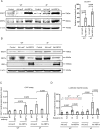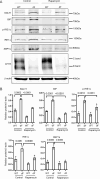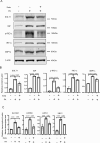XBP1-mediated transcriptional regulation of SLC5A1 in human epithelial cells in disease conditions
- PMID: 38388523
- PMCID: PMC10885492
- DOI: 10.1186/s13578-024-01203-x
XBP1-mediated transcriptional regulation of SLC5A1 in human epithelial cells in disease conditions
Abstract
Background: Sodium-Glucose cotransporter 1 and 2 (SGLT1/2) belong to the family of glucose transporters, encoded by SLC5A1 and SLC5A2, respectively. SGLT2 is almost exclusively expressed in the renal proximal convoluted tubule cells. SGLT1 is expressed in the kidneys but also in other organs throughout the body. Many SGLT inhibitor drugs have been developed based on the mechanism of blocking glucose (re)absorption mediated by SGLT1/2, and several have gained major regulatory agencies' approval for treating diabetes. Intriguingly these drugs are also effective in treating diseases beyond diabetes, for example heart failure and chronic kidney disease. We recently discovered that SGLT1 is upregulated in the airway epithelial cells derived from patients of cystic fibrosis (CF), a devastating genetic disease affecting greater than 70,000 worldwide.
Results: In the present work, we show that the SGLT1 upregulation is coupled with elevated endoplasmic reticulum (ER) stress response, indicated by activation of the primary ER stress senor inositol-requiring protein 1α (IRE1α) and the ER stress-induced transcription factor X-box binding protein 1 (XBP1), in CF epithelial cells, and in epithelial cells of other stress conditions. Through biochemistry experiments, we demonstrated that the spliced form of XBP1 (XBP1s) acts as a transcription factor for SLC5A1 by directly binding to its promoter region. Targeting this ER stress → SLC5A1 axis by either the ER stress inhibitor Rapamycin or the SGLT1 inhibitor Sotagliflozin was effective in attenuating the ER stress response and reducing the SGLT1 level in these cellular model systems.
Conclusions: The present work establishes a causal relationship between ER stress and SGLT1 upregulation and provides a mechanistic explanation why SGLT inhibitor drugs benefit diseases beyond diabetes.
Keywords: ER stress; Epithelial cells; SGLT1; SLC5A1; XBP1.
© 2024. The Author(s).
Conflict of interest statement
The authors declare no conflicts of interest.
Figures







Update of
-
XBP1-mediated transcriptional regulation of SLC5A1 in human epithelial cells in disease conditions.Res Sq [Preprint]. 2023 Jul 21:rs.3.rs-3112506. doi: 10.21203/rs.3.rs-3112506/v1. Res Sq. 2023. Update in: Cell Biosci. 2024 Feb 22;14(1):27. doi: 10.1186/s13578-024-01203-x. PMID: 37502997 Free PMC article. Updated. Preprint.
Similar articles
-
XBP1-mediated transcriptional regulation of SLC5A1 in human epithelial cells in disease conditions.Res Sq [Preprint]. 2023 Jul 21:rs.3.rs-3112506. doi: 10.21203/rs.3.rs-3112506/v1. Res Sq. 2023. Update in: Cell Biosci. 2024 Feb 22;14(1):27. doi: 10.1186/s13578-024-01203-x. PMID: 37502997 Free PMC article. Updated. Preprint.
-
Development of SGLT1 and SGLT2 inhibitors.Diabetologia. 2018 Oct;61(10):2079-2086. doi: 10.1007/s00125-018-4654-7. Epub 2018 Aug 22. Diabetologia. 2018. PMID: 30132033 Free PMC article. Review.
-
The Na+-D-glucose cotransporters SGLT1 and SGLT2 are targets for the treatment of diabetes and cancer.Pharmacol Ther. 2017 Feb;170:148-165. doi: 10.1016/j.pharmthera.2016.10.017. Epub 2016 Oct 20. Pharmacol Ther. 2017. PMID: 27773781 Review.
-
X-box binding protein 1 (XBP1): A key protein for renal osmotic adaptation. Its role in lipogenic program regulation.Biochim Biophys Acta Mol Cell Biol Lipids. 2020 Apr;1865(4):158616. doi: 10.1016/j.bbalip.2020.158616. Epub 2020 Jan 9. Biochim Biophys Acta Mol Cell Biol Lipids. 2020. PMID: 31927142
-
ATF6 upregulates XBP1S and inhibits ER stress-mediated apoptosis in osteoarthritis cartilage.Cell Signal. 2014 Feb;26(2):332-42. doi: 10.1016/j.cellsig.2013.11.018. Epub 2013 Nov 21. Cell Signal. 2014. PMID: 24269637
Cited by
-
Integrated multi-sample transcriptomic analysis of COVID-19 patients against controls using a bioinformatics pipeline.Sci Rep. 2025 Jun 4;15(1):19644. doi: 10.1038/s41598-025-03640-1. Sci Rep. 2025. PMID: 40467710 Free PMC article.
References
-
- Deeks E D. Sotagliflozin: a review in type 1 diabetes. Drugs. 2019;79:1977–87. - PubMed
Grants and funding
LinkOut - more resources
Full Text Sources
Research Materials

